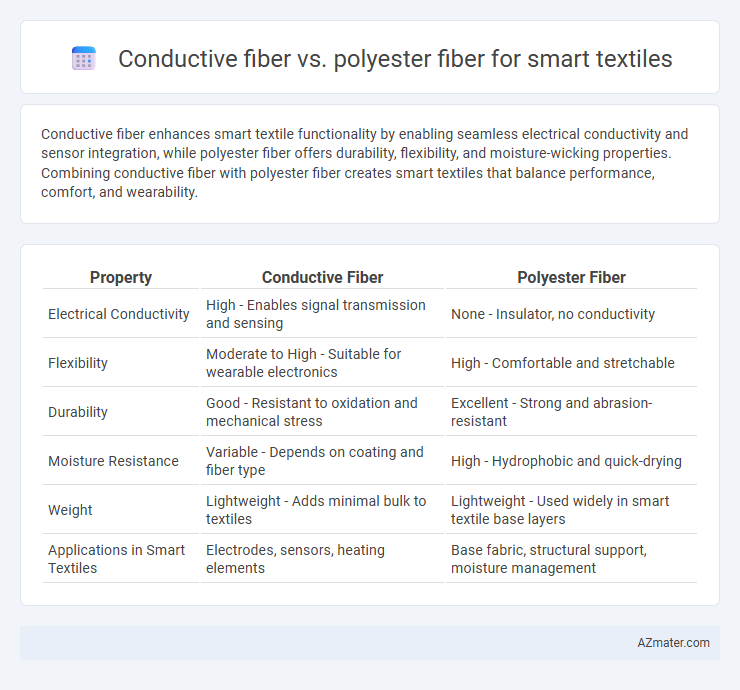Conductive fiber enhances smart textile functionality by enabling seamless electrical conductivity and sensor integration, while polyester fiber offers durability, flexibility, and moisture-wicking properties. Combining conductive fiber with polyester fiber creates smart textiles that balance performance, comfort, and wearability.
Table of Comparison
| Property | Conductive Fiber | Polyester Fiber |
|---|---|---|
| Electrical Conductivity | High - Enables signal transmission and sensing | None - Insulator, no conductivity |
| Flexibility | Moderate to High - Suitable for wearable electronics | High - Comfortable and stretchable |
| Durability | Good - Resistant to oxidation and mechanical stress | Excellent - Strong and abrasion-resistant |
| Moisture Resistance | Variable - Depends on coating and fiber type | High - Hydrophobic and quick-drying |
| Weight | Lightweight - Adds minimal bulk to textiles | Lightweight - Used widely in smart textile base layers |
| Applications in Smart Textiles | Electrodes, sensors, heating elements | Base fabric, structural support, moisture management |
Introduction to Smart Textiles
Smart textiles integrate advanced materials like conductive fibers and polyester fibers to enable electronic functionalities within fabrics. Conductive fibers, composed of metals or carbon-based materials, provide electrical conductivity essential for sensors and wearable devices, while polyester fibers offer durability, flexibility, and moisture resistance, supporting the textile structure. Combining these fibers enhances smart textiles by balancing electronic performance with mechanical comfort and longevity.
What Are Conductive Fibers?
Conductive fibers are specialized textiles embedded with materials such as silver, copper, or carbon nanotubes to enable electrical conductivity, essential for smart textile applications like wearable sensors and health monitoring devices. In contrast, polyester fibers are insulating synthetic fibers commonly used for durability and comfort but lack inherent electrical properties. The integration of conductive fibers into smart textiles enhances functionality by facilitating signal transmission and real-time data collection, surpassing conventional polyester fibers in electronic performance.
Overview of Polyester Fibers
Polyester fibers in smart textiles offer durability, moisture resistance, and ease of processing, making them a popular choice for wearable technology. Their hydrophobic nature ensures quick drying and enhanced comfort, which is crucial for long-term garment use. Compared to conductive fibers, polyester requires additional treatments or coatings to achieve electrical conductivity necessary for smart textile applications.
Electrical Properties: Conductive vs Polyester
Conductive fibers exhibit superior electrical conductivity, enabling efficient signal transmission and responsiveness in smart textiles, unlike polyester fibers which are inherently insulating. The intrinsic resistivity of conductive fibers typically ranges from 10^-6 to 10^-4 O*m, facilitating real-time data collection and energy harvesting. Polyester fibers, with resistivity around 10^12 O*m, serve primarily as structural elements without contributing to electrical functionality.
Durability and Wear Resistance
Conductive fibers exhibit superior durability and wear resistance compared to polyester fibers, making them ideal for smart textiles subjected to frequent bending and stretching. The metal or carbon-based conductive materials maintain electrical integrity under mechanical stress, whereas polyester fibers may degrade more quickly due to abrasion and washing cycles. Smart textiles incorporating conductive fibers ensure long-lasting performance and reliable signal transmission in wearable technology applications.
Flexibility and Comfort in Wearables
Conductive fiber in smart textiles offers superior flexibility compared to polyester fiber, enabling seamless integration into wearable devices without compromising movement. Polyester fiber, while durable and lightweight, lacks the inherent stretch and adaptability found in conductive fibers, potentially reducing comfort in prolonged wear. Enhanced comfort in wearables is achieved through conductive fibers' ability to maintain breathability and softness, crucial for skin contact and long-term usage.
Integration with Electronic Components
Conductive fibers exhibit superior electrical conductivity and flexible integration capabilities, making them ideal for embedding sensors and circuits in smart textiles. Polyester fibers provide robust mechanical strength and durability but lack inherent conductivity, necessitating additional conductive coatings or composite structures. Efficient integration with electronic components depends on the fiber's conductivity, flexibility, and compatibility with textile manufacturing processes, where conductive fibers reduce complexity and enhance reliability in smart textile applications.
Cost and Manufacturing Considerations
Conductive fibers, typically made from metals like silver or copper, incur higher costs due to expensive raw materials and complex manufacturing processes, impacting the overall budget for smart textiles. Polyester fibers, by contrast, offer cost-effective production with established mass-manufacturing techniques and durability benefits, making them a preferred choice for large-scale textile applications. Manufacturing conductive fibers requires precision coating or spinning methods to ensure electrical conductivity, whereas polyester fibers benefit from simpler textile processing compatible with existing industrial equipment.
Environmental Impact and Sustainability
Conductive fibers, often made from metals or carbon-based materials, typically have higher environmental impacts due to resource-intensive extraction and limited recyclability compared to petroleum-derived polyester fibers, which benefit from established recycling infrastructure and energy-efficient production methods. However, advancements in biodegradable polyester alternatives and the potential for conductive fibers to be engineered from recycled materials are enhancing sustainability profiles for both fiber types in smart textile applications. Choosing between conductive and polyester fibers for smart textiles requires balancing performance requirements with environmental considerations such as carbon footprint, biodegradability, and end-of-life recyclability.
Applications in Smart Textile Innovations
Conductive fiber integrates electrical conductivity with textile flexibility, enabling applications in wearable sensors, health monitoring devices, and interactive garments that respond to environmental stimuli. Polyester fiber offers durability, moisture resistance, and ease of dyeing, commonly used as a base for embedding conductive materials in smart textiles for enhanced comfort and mechanical strength. Combining conductive fibers with polyester fibers drives innovations in smart textile products, such as energy-harvesting fabrics, responsive sportswear, and adaptive fashion technology.

Infographic: Conductive fiber vs Polyester fiber for Smart textile
 azmater.com
azmater.com